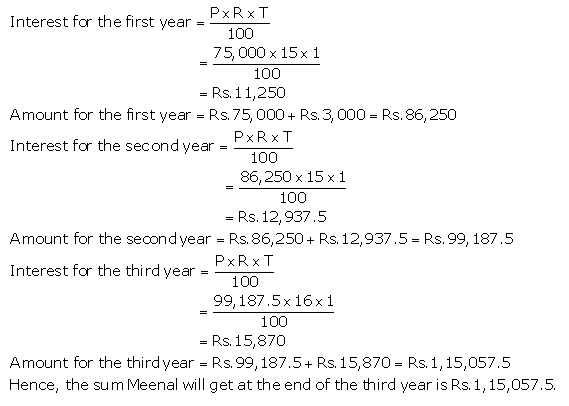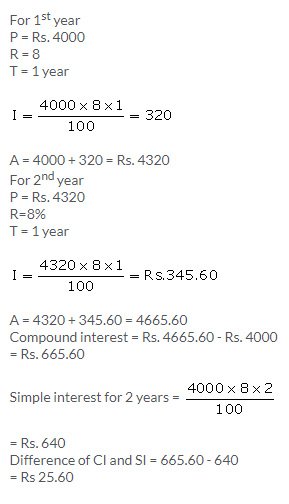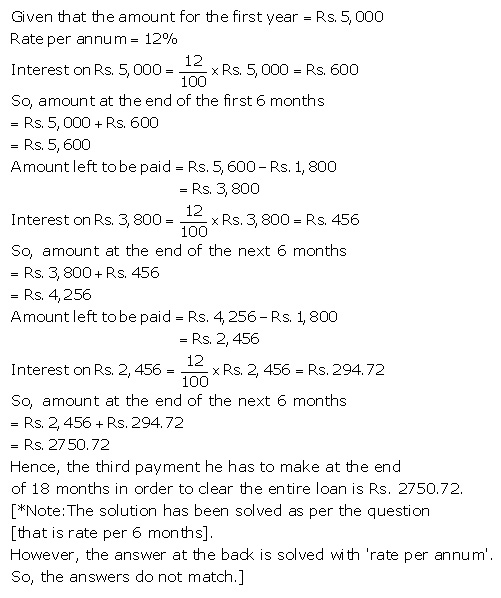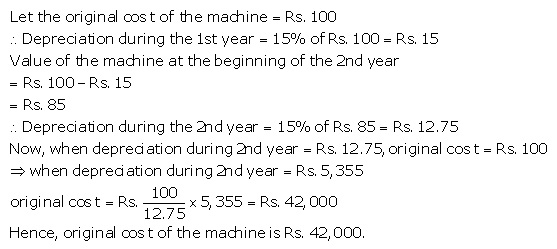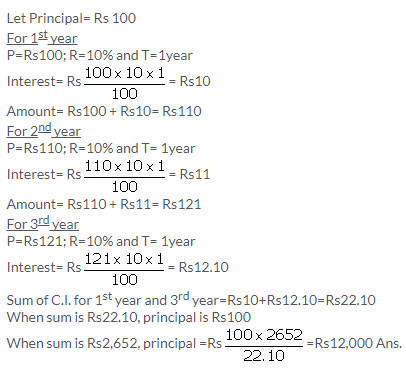Selina Concise Mathematics Class 9 ICSE Solutions Chapter 2 - Compound Interest (Without Using Formula)
Selina Concise Mathematics Class 9 ICSE Solutions Compound Interest (Without Using Formula)
Selina ICSE Solutions for Class 9 Maths Chapter 2 Compound Interest (Without using formula)
Exercise 2(A)
1.
Solution 1:
2.
Solution 2:
3. Calculate the amount and the compound interest on:
(i)
(ii)
Solution 3:
4. Find the compound interest, correct to the nearest rupee, on
Solution 4:
5. Calculate the compound interest for the second year on
Solution 5:
6. A borrowed
Solution 6:
7. How much will Rs. 50,000 amount to in 3 years, compounded yearly, if the rates for the successive years are 6%, 8% and 10% respectively?
Solution 7:
8. Meenal lends Rs. 75,000 at C.I. for 3 years. If the rate of interest for the first two years is 15% per year and for the third year it is 16%, calculate the sum Meenal will get at the end of the third year.
Solution 8:
9. Govind borrows Rs18,000 at 10% simple interest. He immediately invests the money borrowed at 10% compound interest compounded half-yearly. How much money does Govind gain in one year ?
Solution 9:
10. Find the compound interest on Rs. 4,000 accrued in three years, when the rate of interest is 8% for the first year and 10% per year for the second and the third years.
Solution 10:
Exercise 2(B)
1. Calculate the difference between the simple interest and the compound interest on
Solution 1:
2. A man lends
Solution 2:
3.A sum of money is lent at 8% per annum compound interest. If the interest for the second year exceeds that for the first year by Rs.96, find the sum of money.
4.
Solution 4:
5. A man borrows Rs. 6,000 at 5% C.I. per annum. If he repays Rs. 1,200 at the end of each year, find the amount of the loan outstanding at the beginning of the third year.
Solution 5:
6. On a certain sum of money, the difference between the compound interest for a year, payable half-yearly, and the simple interest for a year is
Solution 6:
7. A manufacturer estimates that his machine depreciates by 15% of its value at the beginning of the year. Find the original value (cost) of the machine, if it depreciates by Rs. 5,355 during the second year.
Solution 7:
8. A man invest  5,600 at 14% per annum compound interest for 2 years. Calculate:
5,600 at 14% per annum compound interest for 2 years. Calculate:
(i) The interest for the first year.
(ii) The amount at the end of the first year.
(iii) The interest for the second year, correct to the nearest rupee.
Solution 8:
9.(i)
Solution 9(i):
9.(ii)
Solution 9(ii):
10. A man saves
Solution 10:
11. A man borrows Rs. 10,000 at 5% per annum compound interest. He repays 35% of the sum borrowed at the end of the first year and 42% of the sum borrowed at the end of the second year. How much must he pay at the end of the third year in order to clear the debt?
Solution 11:
12.
Solution 12:
Exercise 2(C)
1. A sum is invested at compound interest, compounded yearly. If the interest for two successive years is Rs.5,700 and Rs.7,410, calculate the rate of interest.
Solution 1:
2. A certain sum of money is put at compound interest, compounded half-yearly. If the interest for two successive half-years are Rs650 and Rs760.50; find the rate of interest.
Solution 2:
3.A certain sum amounts to Rs5,292 in two years and Rs5,556.60 in three years, interest being compounded annually. Find;
(i) the rate of interest.
(ii) the original sum.
Solution 3:
4. The compound interest, calculated yearly, on a certain sum of money for the second year is Rs1,089 and for the third year it is Rs1,197.90. Calculate the rate of interest and the sum of money.
Solution 4:
5. Mohit invests Rs8,000 for 3years at a certain rate of interest, compounded annually. At the end of one year it amounts to Rs9,440. Calculate:
(i)the rate of interest per annum.
(ii)the amount at the end of the second year.
(iii)the interest accrued in the third year.
Solution 5:
6. Geeta borrowed Rs15,000 for 18 months at a certain rate of interest compounded semi-annually. If at the end of six months it amounted to Rs15,600; calculate :
(i) the rate of interest per annum.
(ii) the total amount of money that Geeta must pay at the end of 18 months in order to clear the account.
Solution 6:
7. Ramesh invests Rs12,800 for three years at the rate of 10% per annum compound interest. Find:
(i)the sum due to Ramesh at the end of the first year.
(ii)the interest he earns for the second year.
(iii)the total amount due to him at the end of the third year.
Solution 7:
8.
Solution 8:
9.
Solution 9:
10. Rs8,000 is lent out at 7% compound interest for 2years. At the end of the first year Rs3,560 are returned. Calculate :
(i) the interest paid for the second year.
(ii) the total interest paid in two years.
(iii) the total amount of money paid in two years to clear the debt.
Solution 10:
11. The cost of a machine depreciated by Rs.4,000 during the first year and by Rs.3,600 during the second year. Calculate:
The rate of depreciation.
The original cost of the machine.
Its cost at the end of the third year.
Solution 11:
12.
Solution 12:
13. Find the sum, invested at 10% compounded annually, on which the interest for the third year exceeds the interest of the first year by Rs252.
Solution 13:
14. A man borrows Rs10,000 at 10% compound interest compounded yearly. At the end of each year, he pays back 30% of the sum borrowed. How much money is left unpaid just after the second year?
15. A man borrows Rs10,000 at 10% compound interest compounded yearly. At the end of each year, he pays back 20% of the amount for that year. How much money is left unpaid just after the second year?
Solution 15:
Exercise 2(D)
1. What sum will amount of
Solution 1:
2. The value of a machine depreciated by 10% per year during the first two years and 15% per year during the third year. Express the total depreciation of the machine, as per cent, during the three years.
Solution 2:
3. Rachna borrows Rs12,000 at 10 percent per annum interest compounded half-yearly. She repays Rs4,000 at the end of every six months. Calculate the third payment she has to make at end of 18 months in order to clear the entire loan.
Solution 3:
4. On a certain sum of money, invested at the rate of 10 percent per annum compounded annually, the interest for the first year plus the interest for the third year is Rs2,652. Find the sum.
Solution 4:
5. During every financial year, the value of a machine depreciates by 12%. Find the original cost of a machine which depreciates by Rs2,640 during the second financial year of its purchase.
Solution 5:
6. Find the sum on which the difference between the simple interest and compound interest at the rate of 8% per annum compounded annually would be Rs.64 in 2years.
Solution 6:
7. A sum of Rs13,500 is invested at 16% per annum compound interest for 5years.Calculate:
(i) the interest for the first year.
(ii) the amount at the end of first year.
(iii) the interest for the second year, correct to the nearest rupee.
Solution 7:
8.Saurabh invests Rs48,000 for 7 years at 10% per annum compound interest.
Calculate:
(i) the interest for the first year.
(ii) the amount at the end of second year.
(iii) the interest for the third year.
Solution 8:
9. Ashok borrowed Rs.12,000 at some rate on compound interest. After a year, he paid back Rs.4,000. If the compound interest for the second year is Rs.920, find:
The rate of interest charged
The amount of debt at the end of the second year
Solution 9:
The amount of debt at the end of the second year is equal to the addition of principal of the second year and interest for the two years.
Debt = Rs.8,000 + Rs.1200 + Rs.920 = Rs.10,120
10. On a certain sum of money, lent out at C.I., interests for first, second and third years are Rs. 1,500; Rs. 1,725 and Rs. 2,070 respectively. Find the rate of interest for the (i) second year (ii) third year.
Solution 10:









